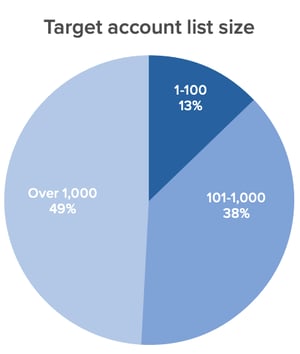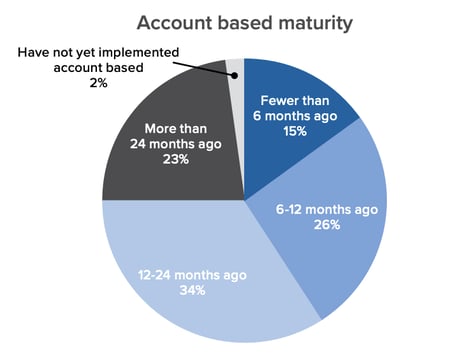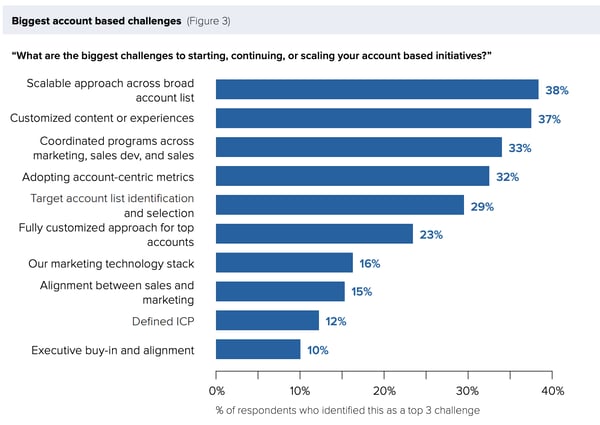As marketers, we've become experts in our target audiences. We know their typical demographic, what they like, the platforms they spend time on, and what they value in a product.
But unlike sales reps — who talk to and learn from our biggest prospects each day — we don't always know tiny, but crucial, details about the brands or people we most want to sell too. This might be why only 28% of salespeople say marketing is their best source of leads.
So, how do we bridge the gap to better help our sales teams sell to high-priority clients? The answer to this question could be account-based marketing (or ABM).
Rather than just marketing to a broad target audience and hoping someone calls your sales reps, ABM is a strategy where sales and marketing teams align from the start to create campaigns that cater to their most qualified leads and current customers.
For example, as part of an ABM strategy, sales reps might offer marketing teams data from customers, prospects, and those that didn't buy a product so that the marketers can create a targeted campaign that amplifies why their product is valuable and how it can help targets navigate daily pain points.
While inbound marketing is vital for pulling general audiences and demographics to your site, service, or store, account-based marketing can help you to reel in prospects or qualified leads that are most likely to buy your product.
To show you just how beneficial account-based marketing can be, while also informing you of the challenges it comes with, here are 36 stats you should know in 2020.
36 Account-Based Marketing Stats to Know in 2020
General ABM Stats
- 67% of brands leverage account-based marketing. (HubSpot)
- “Researching Accounts” and “Identifying Target Contacts” are the top two tactics used by marketers within an ABM model. (HubSpot)
- Just one year ago, the top five account-based tactics were sales development rep outreach, digital advertising, direct mail, marketing email, and events. (TOPO)
- Additionally, marketers strongly agree that personalized content (56%) and advanced data management (43%) are keys to ABM's success. (Forrester)
- Most organizations intentionally only pursue 38% of their target accounts at one time. (TOPO)
- By 2019, 55% of marketers rated their ABM strategy as “established” compared to just 43% in 2018. (Forrester)
- Companies dedicated 29% of their marketing budgets to ABM in 2019. (Engagio)
- It's estimated that ABM budgets saw an average increase of 41% in 2019. (TOPO)
- 57% of professionals say their companies target 1,000 accounts or under with ABM. (TOPO)

- At the beginning of 2018, only 18% of adopters had two years of experience in account-based marketing. (TOPO)
- In 2018, 18% of account-based programs were run against current customers (larger organizations with more than $1 billion in revenue ran about 50% of these programs. (TOPO)
- The most common metric marketers use to track ABM is revenue won. (HubSpot)
- Two other metrics marketers most commonly track to measure ABM efforts are the number of pipelines created and account engagement. (Engagio)
- In 2019, 7% of marketers reported a decrease in dedicated headcount for ABM teams, showing that this strategy is going mainstream and being implemented within regular processes. (Forrester)
- In 2019, 40% of the average marketing team was dedicated to ABM. (Engagio)
- 57% of marketers say their organizations have implemented ABM for more than one year. (TOPO)

Benefits and Challenges of ABM
- Marketing and sales teams that take an ABM approach together can be up to six percent more likely to exceed their revenue goals than teams less ABM-advanced. (Forrester)
- 62% of marketers say they can measure a positive impact since adopting ABM. (Forrester)
- 80% of marketers say ABM improves customer lifetime values, while 86% say it improves win rates. (TOPO)
- 87% of account-based marketers say that ABM initiatives outperform other marketing investments. (ITSMA)
- One in five accounts targeted through ABM becomes considered a qualified sales opportunity. (TOPO)
- Organizations with a strong Ideal Customer Profile (ICP) — which is similar to a buyer persona — achieve 68% higher account win rates. (TOPO)
- More than two-thirds (69%) of top-performing account-based organizations now have a dedicated account based leader. (TOPO)
- 70% of companies that started account-based initiatives in the first six months of 2019 have dedicated ABM leaders. (TOPO)
- 42% of companies that missed their account-based objectives don't have dedicated leadership. (TOPO)
- The most common challenge with ABM is delivering a personalized experience. (HubSpot)
- The top three challenges of implementing ABM are creating a scalable strategy for multiple accounts, producing customized content, and coordinating programs across marketing, sales development, and sales teams. (TOPO)

ABM Technology
- By 2021, over half of all sales phone calls will be analyzed by software. (TOPO)
- The conversational intelligence market was estimated to grow by 3x in 2019. (TOPO)
- Voice assistants will account for at least half of automated data entry by mid-2020. (TOPO)
- An estimated 55% of sales data entry was eliminated by automation by 2020. (TOPO)
Smarketing Benefits and Challenges
- Organizations with tightly aligned sales and marketing teams experience 36% higher customer retention rates. (MarketingProfs)
- The most common measurement of success for content marketing programs is Total Sales. (HubSpot)
- 85% of marketers with an SLA think their marketing strategy is effective. (HubSpot)
- Only 7% of salespeople said leads they received from marketing were very high quality. (HubSpot)
- Only 28% of salespeople said marketing was their best source of leads (HubSpot)
Create an Effective ABM Strategy
As a marketer, it's important to know what makes ABM techniques successful and how they differ from other target audience marketing tactics.
Additionally, you'll want to learn about the companies you're interested in marketing to, similar to how you learn about a target audience. For example, before creating an ABM campaign, you'll want to learn about the pain points of companies in your industry, company missions, and what their top decision-makers value in a product or service.
Once you discover valuable data about the accounts you'd like to market to and feel ready to create a campaign, check out our Ultimate Guide to Account-Based Marketing.
Editor's note: This post was originally published in May 2020 and has been updated for comprehensiveness.
No comments:
Post a Comment